In this blog, I'm sharing my most powerful tips that work in dog training, especially if you are dealing with fear aggression in dogs.
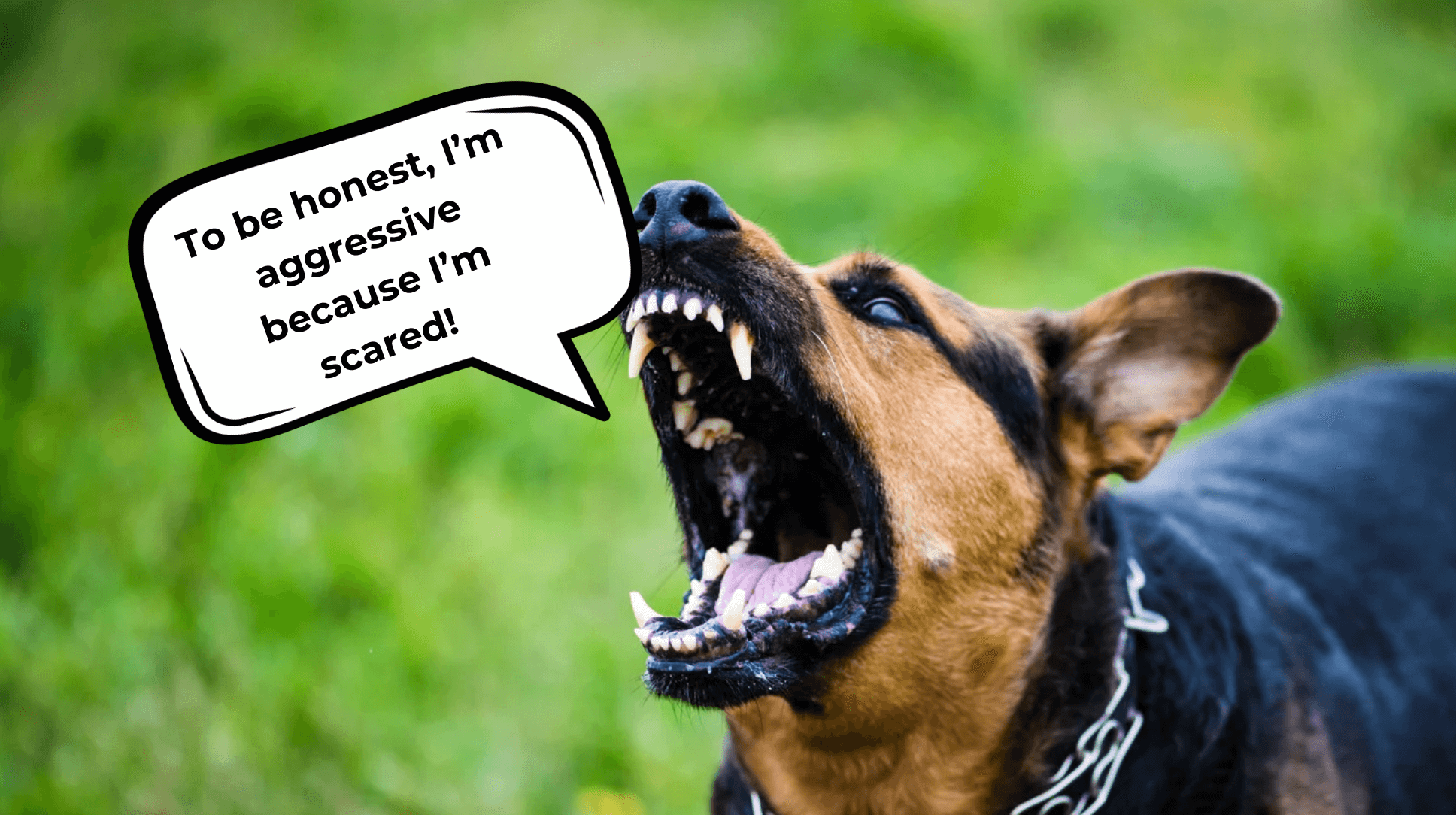
Aggression due to fear (for example, territorial aggression and aggression from overprotectiveness) is a dangerous behavior problem that should be addressed correctly.
There are so many strategies online telling you how to deal with fear-related aggression. Some of them MAY work, but remember that without getting into your dog's psyche, it's hard to calm a dog down.
I'm going to share my experience on how I helped a fear-aggressive dog overcome this behavior.
Let's start.
Key Takeaways:
- Fear aggression is often a dog's way of communicating discomfort and fear, not inherent meanness. Dogs like Buck may have past experiences that make them wary of human interaction. Their growls and snaps are often a warning sign to increase distance, not necessarily an attempt to bite.
- Understanding the root cause of fear aggression is crucial for effective training. Factors like genetics, past trauma, and unaddressed reactivity can contribute to fear-based behaviors. Recognizing the subtle signs of fear and anxiety in your dog, such as tense body posture, whale eye, or excessive lip licking, can help prevent escalation to aggression.
- Building trust and providing strong leadership are key to helping a fear aggressive dog. Creating a safe environment, controlling interactions, and using positive reinforcement can help your dog overcome their fears and learn to trust again. Patience and professional guidance can be invaluable in this process.
Table of Contents
Meet Buck: A Fear-Aggressive Dog
Buck, a dog I've had the privilege of working with, is one of those “underdogs” who totally captured my heart. He's a dog I learned a lot from, and I think you will too.
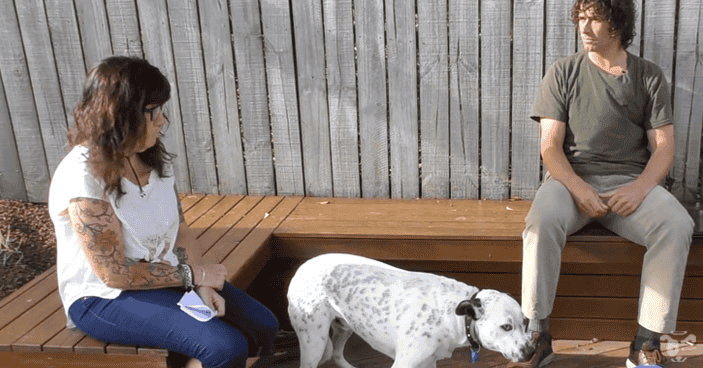
So, before you continue, check out this quick video clip of me working with Buck.
Now that you've watched the video, I thought I'd share with you a few things that come to mind as I look back at my time with Buck about aggression, fear and the ability that dogs have to change
Did Buck Try To Bite Me?
No. If Buck had wanted to, he would have got me. Trust me – a dog's bite is lightning quick and rarely misses the mark.
So why did Buck growl and snap?
Buck's growl and snap were simply to warn me off because he was unsure and didn't want me to stroke him anymore.
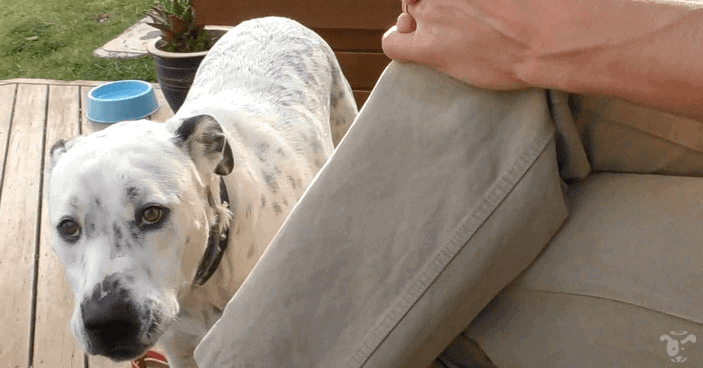
It was nothing more.
If you watch it closely, there is no way he is trying to bite. He simply growls and turns his head towards me. Remember dogs don't speak English, so it's very easy to misinterpret them.
Dogs will often growl like this at another dog if they get too close to their food or invade their space…it's how they communicate.
DOG AGGRESSION OR DOG REACTIVITYCould The Incident Have Been Avoided?
Yes.
With hindsight (video replays are great!), if I had been watching more closely, I might have picked up on what would happen and chosen not to pat Buck. However, when you call them over, most dogs are happy to have this interaction.
However, knowing what we do about Buck's past, we need to look after him more than most dogs.
How Does Buck Feel After The Snap?
The fact that Buck stays next to me after the incident and is so relaxed and happy says it all.
He likes me. He wants to hang out next to me; however, right now he doesn't want to get too familiar, which is perfectly fine. By the end of the clip, he is relaxed in my presence and chooses to lie next to me.
In a way, he's telling me that he'd like to slow the relationship down!
Overall, it's a great result!
Seeing Buck's Potential
It's so easy to feel sorry for dear Buck; however, we need to move on from the past and not keep spoiling him because we think of him as ‘poor Buck'. This sort of thinking will leave him as poor Buck forever. Dogs have a very uncanny ability to sense energy and how we feel.
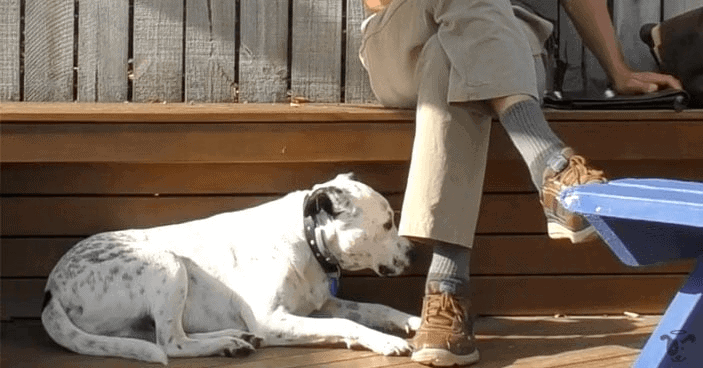
If we want to help him overcome his aggression and fear, we must start visualizing him as a confident boy. Then that's what he'll start to feel.
STOP AGGRESSION DUE TO REACTIVITYDo We Need To Tell Him Off For Snapping?
No. Snapping is Buck's way of saying back off. It's how dogs communicate, so I would listen and learn from that.
If Buck had actually bitten me, then that's different and yes, I would suggest that we should pop him into time-out to show him that what he did was unacceptable.
A short time-out is more powerful than telling him off verbally—a calm consistent consequence to his actions is what he needs. Not some verbal abuse that leaves everybody stressed.
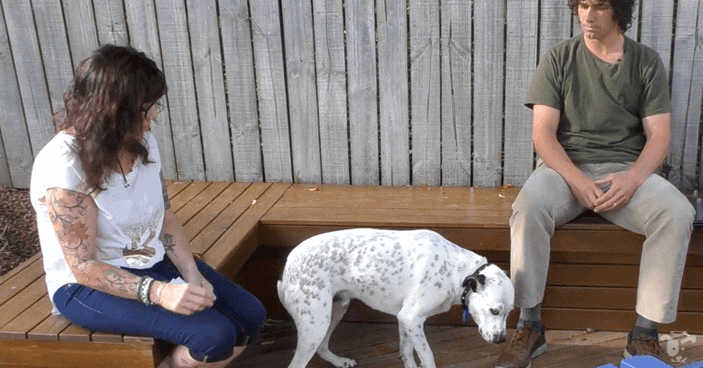
Let's remember Buck's reaction did not come out of meanness or aggression. He got nervous and possibly went a bit over the top when he asked me to stop.
In the words of one great horseman…
‘You have to let a horse (dog) make mistakes, they can't be too scared to make mistakes.' – Buck Brannaman
Understanding an Aggressive Dog's Behavior: What Really Makes A Dog Aggressive?
A puppy's socialization period is usually from 4 to 12 weeks of age. Socialization is a big part of an 8-week-old dog's puppy schedule. Exposure to dogs, people, and certain stimuli can help dogs become less fearful.
This stage significantly shapes the associations a puppy will form. Positive experiences with humans during this period can foster trust. Conversely, negative experiences can lead to a lack of trust. This underscores the importance of early socialization in shaping a dog's behavior and trust towards humans.
Buck could have gotten a better start, which is partly why he's so fearful around humans.
The issue is also worsened when a dog like Buck feels responsible for protecting the pack and the home. This feeling can put incredible stress on him as he may not feel like he's cut out for the job, leaving him jumpy, fearful and potentially aggressive.
So, much more work is required to help Buck trust humans again.
GET DOG CALMING CODE FOR FREEBefore Starting Fear Aggression Training, Take Note of The Other Factors For Your Dog's Aggressive Behavior
Fear aggression is a common behavioral issue in dogs, and understanding its root causes is crucial for effective treatment. By identifying the triggers, we can create a safe and positive environment for our dogs.
Here's a breakdown of some key factors that contribute to fear aggression in dogs:
Genetic Predisposition
While not a definitive cause, certain breeds may be more prone to exhibiting fear-based aggression due to their breeding history.
Breeds bred for guarding or protection, such as German Shepherds, Doberman Pinschers, Rottweilers, and Chow Chows, may have a lower tolerance for unfamiliar situations or perceived threats. However, it's important to remember that this is not a guarantee and responsible socialization can significantly stop these tendencies.
Negative Experiences
Traumatic events in a dog's life, such as abuse, neglect, or being startled or hurt by another dog or person, can leave a lasting impact and make aggressive behaviors surface.
Fear aggressive dogs associate certain stimuli with fear, leading to aggressive reactions in similar situations.
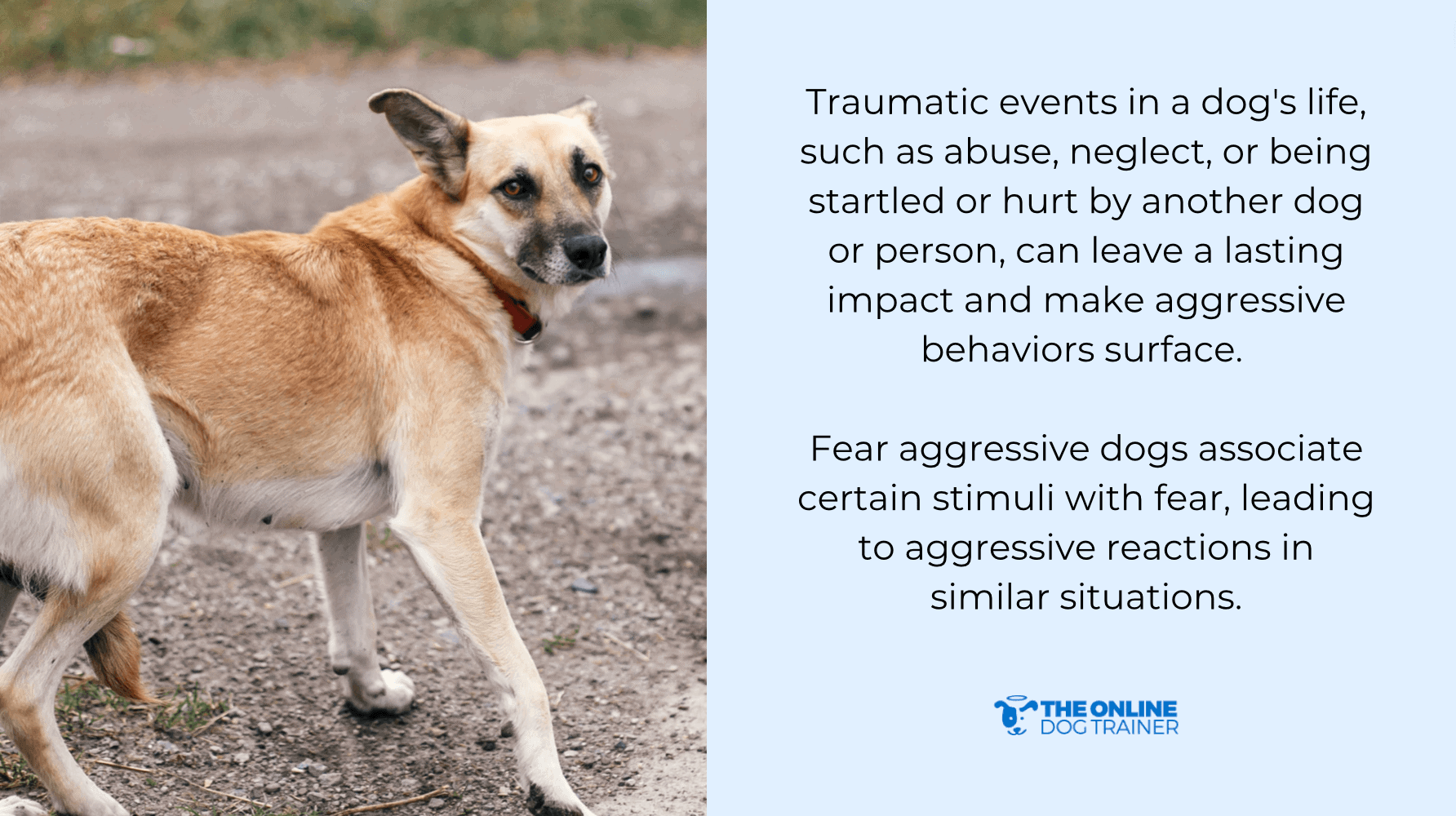
If your dog shows possessive aggression, they could have been denied of food in the past..
If your dog resorts to fear biting, they could have an experience where biting was the best defense move.
LEARN THE DOG CALMING CODE FOR FREEUnaddressed Reactivity
Dogs who exhibit reactivity, which can involve barking, lunging, or growling at triggers, need proper training and guidance to manage these behaviors. If left unchecked, reactivity can escalate into fear aggression over time.
Discomfort and Pain
Underlying medical conditions or injuries can cause a dog significant discomfort. When approached or touched in a way that triggers pain, a dog might react defensively out of fear.
Feeling Threatened
Dogs communicate their discomfort through body language, such as growling, lip curling, or flattened ears. Before a dog bites, they will give off early warning signs such as a fixed stare or a low growl.
If these signals are ignored or punished, the dog may feel they have no choice but to escalate to aggression to feel safe.
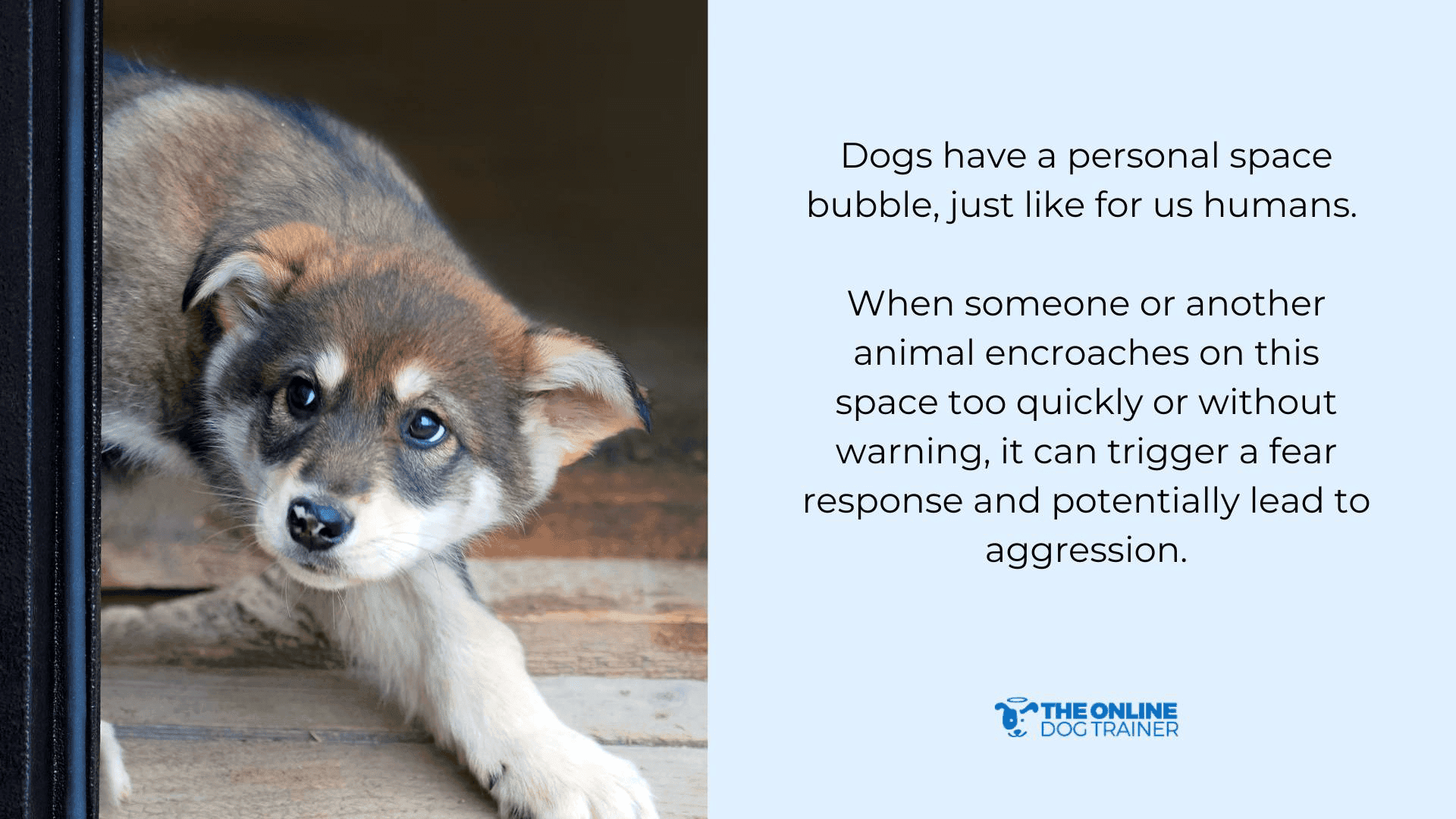
Invading Their Space
Dogs have a personal space bubble, just like for us humans.
When someone or another animal encroaches on this space too quickly or without warning, it can trigger a fear response and potentially lead to aggression.
Understanding Fear Aggression: Subtle Signs Your Dog Is Showing Aggressive Behavior
Dogs are masters of communication, but often their messages are nonverbal. If you want to catch the early signs your dog is turning aggressive, look at their body language!
Here are more subtle signs your dog might be feeling uncomfortable and escalating towards aggression:
Tense Body Posture
If your dog is showing a stiff body with a raised tail (not wagging) or lowered posture with tucked tail they are experiencing anxiety or fear. When not corrected, this reaction to fear can progress to aggression.
Hard Stare
Direct, unwavering eye contact, especially with narrowed eyes, is a sign your dog feels threatened and is trying to intimidate.
Wrinkled Brow and Raised Hackles
Fur standing on end along the back (hackles raised) combined with furrowed brow or wrinkles around the eyes is a clear warning sign. This canine behavior is meant to intimidate the threat.
Lip Licking and Yawning
While sometimes a sign of appeasement, excessive lip licking or yawning out of context can indicate stress and potential aggression.
Growling
A low growl is a clear warning that your dog perceives a threat getting near its space. It's important to take this signal seriously and avoid escalating the situation.
Whale Eye
This refers to the whites of the eyes being visible when the dog looks at you. It's a sign of extreme discomfort and a potential precursor to a bite.
Sniffing the Air Excessively
Rapid sniffing, especially accompanied by a wrinkled nose and tense body language, can indicate the dog is trying to gather information about a perceived threat and may be preparing to act.
Freezing
While some might misinterpret this as calmness, freezing in place can be a sign of conflict avoidance or a precursor to a defensive attack.
Remember, these signs can vary depending on the dog. If you notice any of these behaviors, it's a need to remove the trigger and give your dog space. It's also crucial to consult a professional dog trainer or a veterinary behaviorist to address the underlying cause and prevent future incidents.
STOP REACTIVITY WITHOUT FOOD BRIBESWill A Dog's Fear Aggression Completely Go Away?
Your dog's fear and aggression can never “fully” go away. Healing can take some time, but that doesn't mean your dog can never truly live a life where he can feel safe and ready to trust again.
The best thing about dog aggression training is that it helps manage your dog's condition, and help them overcome their fears.
With proper training – and love, of course – fears and aggressive behavior can be reduced.
How Proper Fear Aggression Training for Dogs Help With Fear-based Bad Habits and Aggressive Behavior
Whether you do it yourself, or get a professional dog trainer help you, fear aggression training can make your dog understand the following:
- It's okay to trust again because they're surrounded by people who love them.
- They no longer have to fight for food just to survive.
- They can make mistakes without fearing that they'll get kicked or hit again.
- They can listen to you because they know they can trust you.
Training a Fearful, Aggressive Dog: Teaching Your Dog How to Be Less Scared and More Trusting
You must first gain his trust to help a dog that is afraid of people. Remember, your dog aggression comes from a place of fear.
Here are some of the key things to bear in mind to helping a dog like this learn to trust again.
#1: Provide Fearful Dogs With Strong Leadership
Going back to Buck, It's important for him to know that you are in charge, that you are the protector, the defender of the property and decision maker. Once he understands this, he can switch off, relax and leave all that decision making to you when visitors come round.
#2: Learn to Reward Calm Energy
When your dog is barking or growling or very fearful, the best thing is to stay calm yourself. You want to avoid talking in a high voice saying things like ‘It's okay Buck, it's alright, nobody's going to hurt you.' This only adds fuel to the fire. If a dog is stressed, stay silent and move him away to a place where he can relax.
DOWNLOAD your free report: “5 Warning Signs of Stress in Dogs“
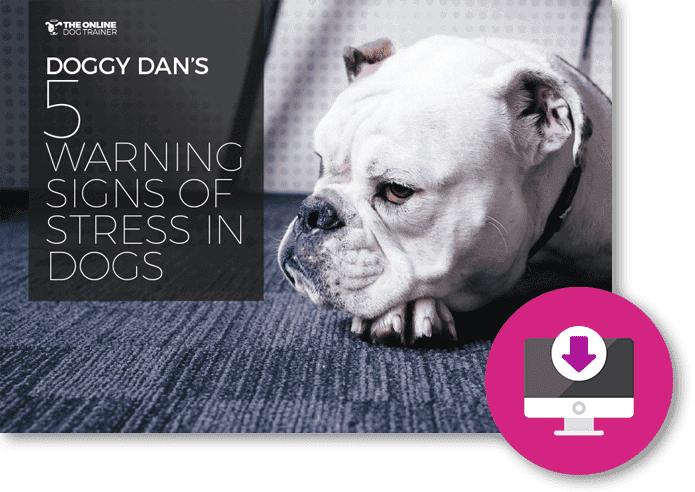
#3: Set Him Up to Win
You can prevent fear aggression by providing your dog a safe space where they can feel confident and relaxed. For that reason, it's important to control the environment in which the dog is in. In Buck's case, if a situation arises where there are lots of people, and young kids turning up, it's best to move him into a back room where he is safe, and you get through without an incident until he is up to it.
#4: Choose Carefully the People That the Dog Meets
When you want a naturally fearful dog to meet a person, make sure that the person is calm. In fact, the best person is the one who is happy to come round and pretty much ignore the dog and then leave.
Stay away from people who want to go over to him and get into his space. And yes, this usually includes some ‘dog lovers'!
#5: Take it Slowly
Fearful dogs, like Buck, need time, and there is no rush, so play it safe. Don't put a dog in a stressful situation until you know he can handle it. Time is on your side…so use it to your advantage.
Also use positive reinforcement to instill in your dog's mind what is the expected behavior from them.
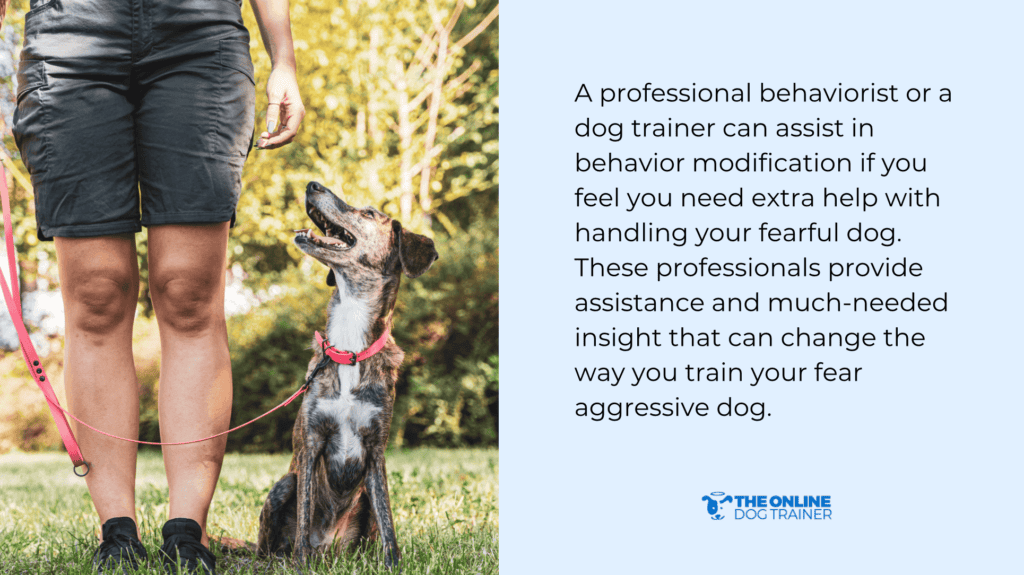
#6: Ask for Professional Help
A professional behaviorist or a dog trainer can assist in behavior modification if you feel you need extra help with handling your fearful dog. These professionals provide assistance and much-needed insight that can change the way you train your fear aggressive dog.
JOIN MY FREE REACTIVITY CLASSIs It Canine Aggression or Dog Reactivity?
Now that I addressed fear aggression in dogs, let me talk about the other important behavior issue often confused as aggressive behavior: dog reactivity.
Your dog's protective aggression can be a fear response out of reactivity and not out of the desire to hurt.
But what is dog reactivity?
Pet parents, I want you to know this: it's important to distinguish fear aggression in dogs from dog reactivity.
Why?
Because dealing with dog reactivity requires a different approach, one that lets your dog know “There's nothing to be reactive about.”
What Is the Difference Between Dog Reactivity and Defensive Aggression?
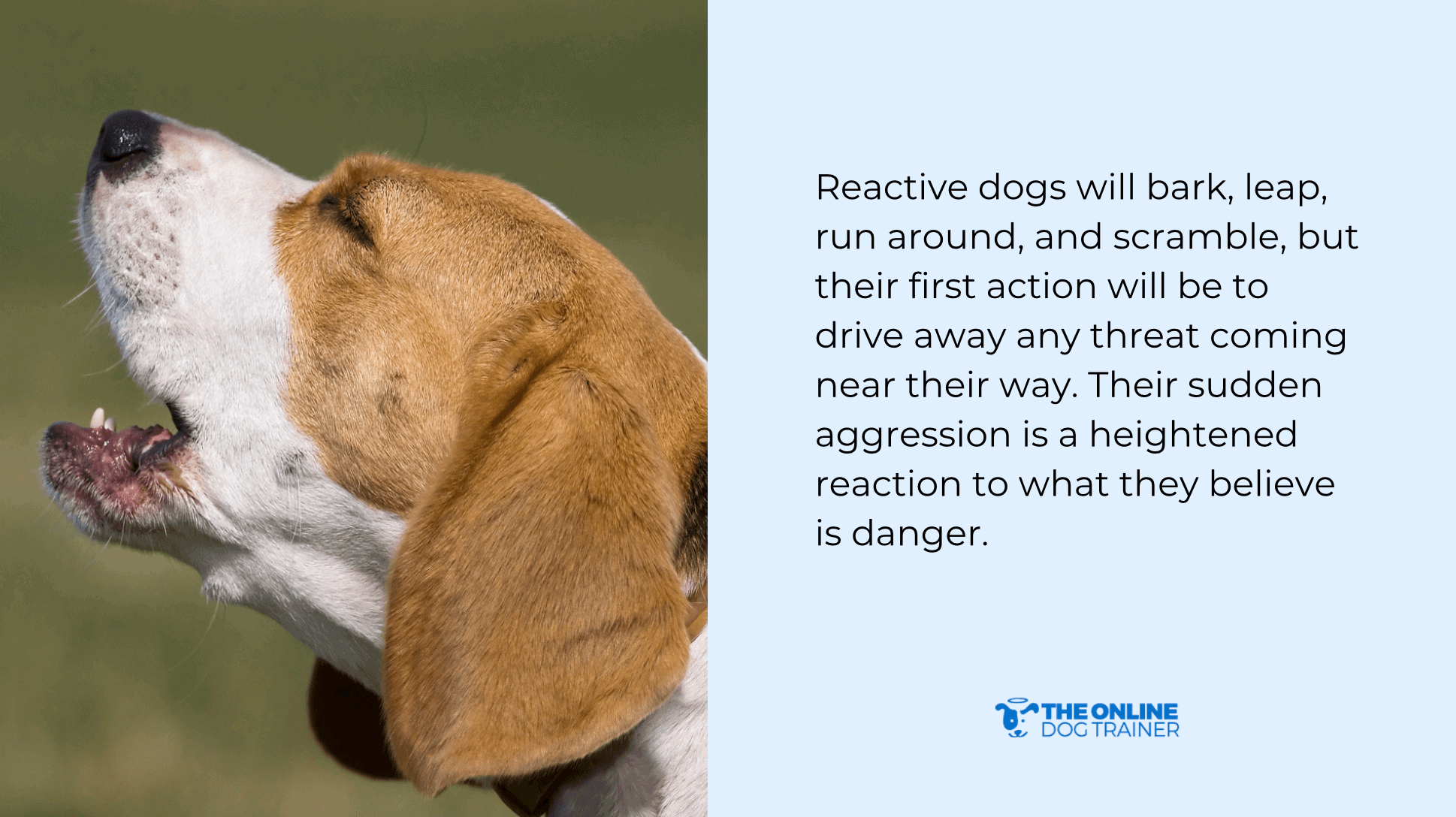
What seemingly looks like territorial, social, or predatory aggression can still be traced back to reactivity.
Here are the three main differences between reactivity and aggressive dog behavior.
- Reactivity is an overreaction to stimuli.
- An over-reactive behavior is caused by a dog's flight or fight response. When a dog feels trapped, they will exhibit extreme reactive behavior to drive away the threat.
- Reactivity comes from the need to defend, not a desire to hurt.
Reactive dogs will bark, leap, run around, and scramble, but their first action will be to drive away any threat coming near their way. Their sudden aggression is a heightened reaction to what they believe is danger.
Many dogs with reactivity problems show aggressive behavior to protect themselves in stressful situations and to let the threat know, “I'm barking, I'm lunging. I can defend myself, so stay away!”
In aggression, a dog believes it has to resort to fighting or hurting another just to survive.
Can reactive dogs adopt aggressive, predatory behavior? I always remind every pet parent I talk to that a reactivity problem not addressed can turn to aggression. When a reactive dog feels helpless, as if it no longer has any option, it switches from defense to attack mode.
If your dog is usually very sweet but starts to behave aggressively when things or people that trigger fear come near, they could be reactive dogs.
I talk more about dog reactivity in this blog.
LEARN MORE ABOUT DOG REACTIVITYFear Aggression in Dogs: You Can Help Your Dog Change!
After helping over 100,000 dogs, I know the most common dog behavior issues can be solved with the right training and understanding dog psychology.
You can help your fear aggressive dogs! My bestselling program, The Online Dog Trainer, aims to equip every pet parent with strategies for dealing with reactive and aggressive dogs.
If you're interested in learning more ways to work with dogs that have different types of aggression issues. In that case, I invite you to request more information about my Dog Trainer Academy program!
Cheers for now, and look after your wonderful dog!

~Doggy Dan

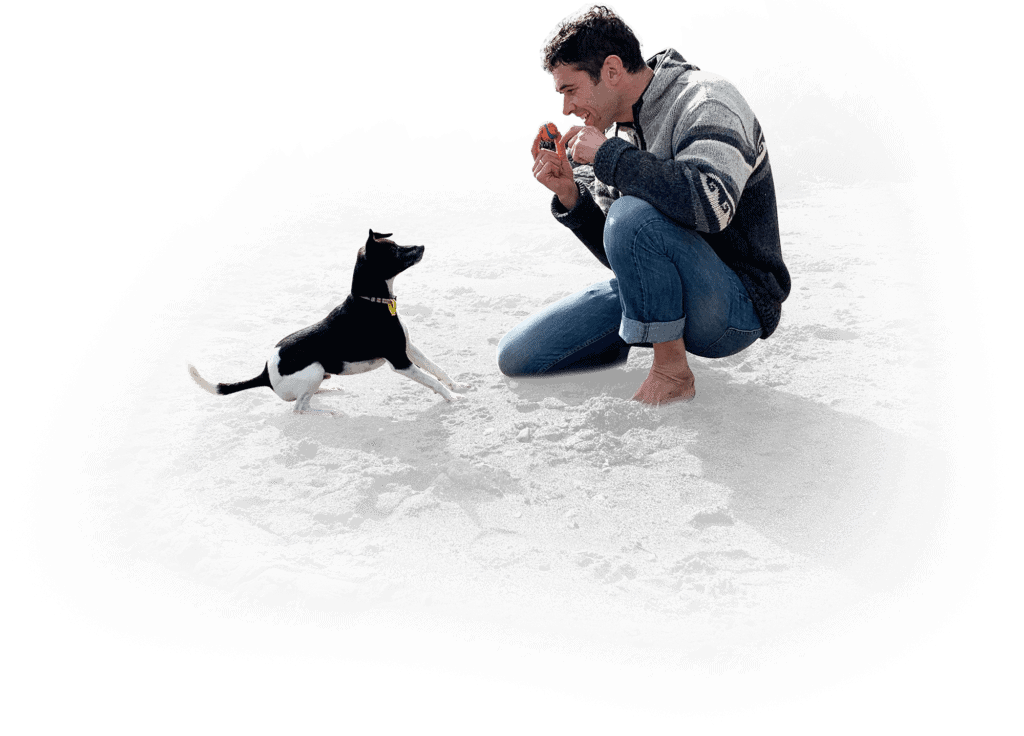
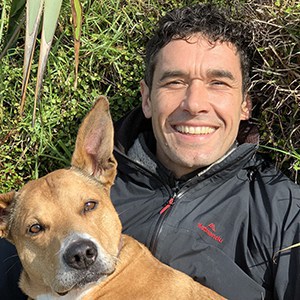
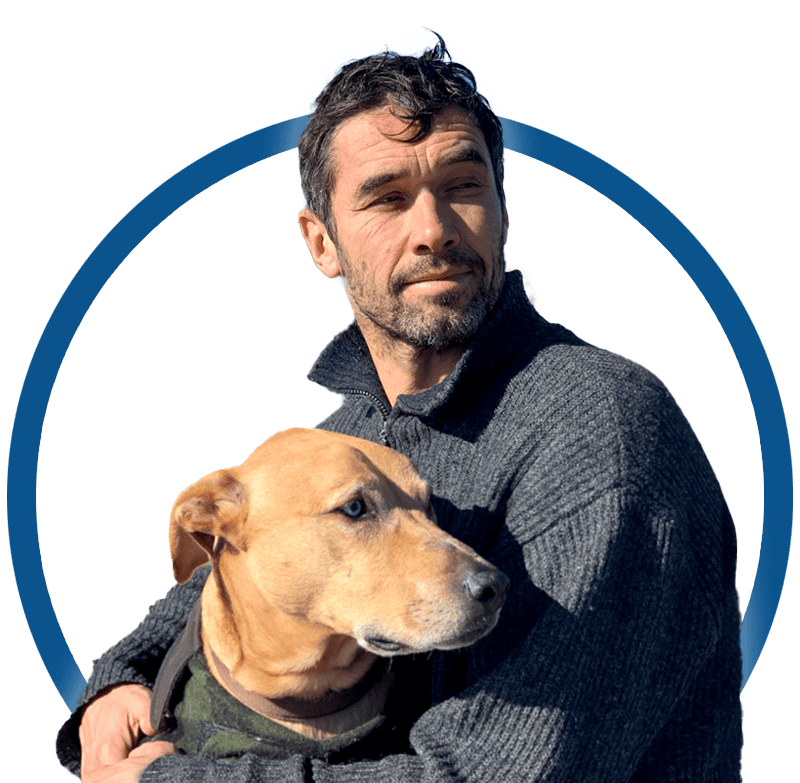
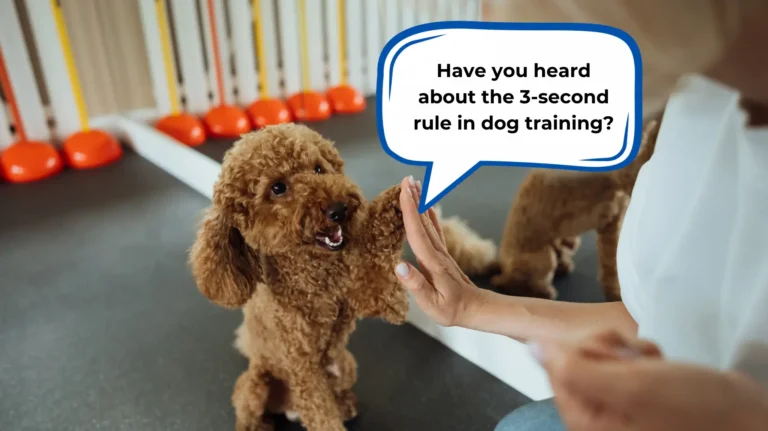
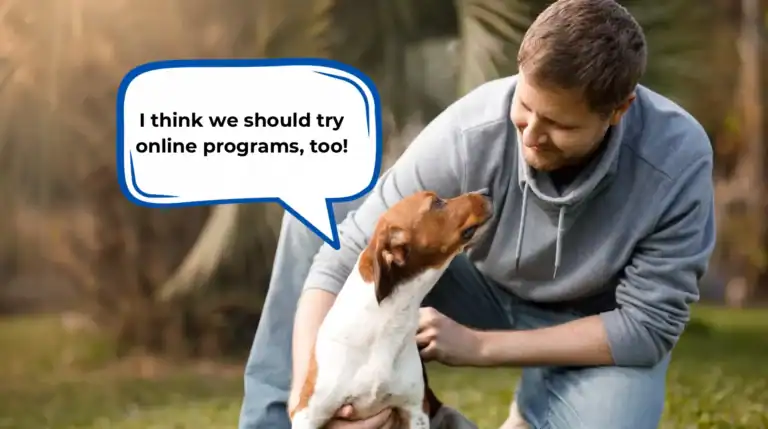
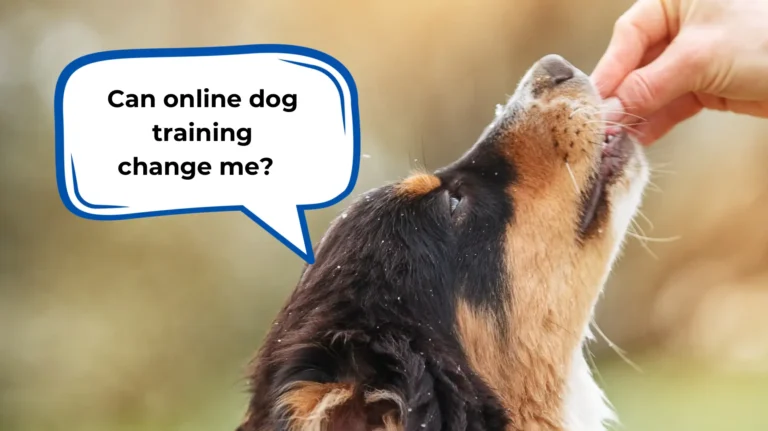
25 Responses
Hi Dan,
My 3 yr. old Catahoula has recently started lunging, & once bit, a person for hugging me. He’s known this person his whole life & this person was in my home for hours prior to without any issue. A month later he did the same thing but I had him on a leash so he only lunged, no bite. It’s definitely fear/protection but is a new behavior. Why now? Why at 3?
We’re very social people but now worried he can’t be social with us. Do you recommend a subtle muzzle of any kind that we could use around people? We want something that will provide protection to people but also be comfortable for him. Thank you!
A muzzle is a good idea for now. I recommend Baskerville.
However, it’s important to understand WHY he’s behaving this way. That way you can then help him to switch off and relax. Check out the free webinar, you’ll love it!
The Reactivity Webinar happens weekly on Wednesday and Sunday at 3pm EST (USA time). The link for the webinar is here, and you can choose this week or the following week: https://theonlinedogtrainer.com/reactivity-webinar/
If you register, you’ll get the recording via email after the webinar
Hi Doggy Dan,
Our dog is a Black Mouth Curr. She is 1 ½ yrs old, 70ish lbs, and generally a super sweet girl. However, if you touch her neck (around her collar) or her feet, or try to bathe or even just wipe her down with a damp rag, she freaks out and bites. She’s always very repentant afterwards and knows she did something she’s not supposed to do. I usually respond with, “Ow! No mouth.” It’s not working. I don’t know what to do. She doesn’t have any trauma in her past (that I’m aware of). We’ve had her since she was 6 weeks old. Advice please?
The most important step in correcting this behaviour is to understand WHY your dog is behaving this way. Very often this is to do with them thinking they are more important than they actually are – hence (in the dog way) “telling off” the human who tries to correct them. When you are able to communicate to them that they can switch off and relax because the humans are in charge, everything changes and becomes a lot easier.
Here is a link to a blog post that explains more about dog aggression:
http://theonlinedogtrainer.com/the-ultimate-guide-to-dealing-with-dangerous-dog-aggression-issues/
… and here’s one about dogs biting their owners : http://theonlinedogtrainer.com/when-dogs-bite-their-owners/
You would also benefit from one of my programs. I’d recommend The Complete Pack http://theonlinedogtrainer.com
All the best, Dan
Hi Dan
I have a 2yr old Wolfhoundx who has aggression tendencies, currently I am seeing a behavioralist for him but it very much seems like it is 2 steps forward and 10 steps back!!
I am really worried that he will never achieve the level where I freely take him around humans and dogs, I have spent so much time and money on trying to solve the issues but with little to no result!
I am worried he will hurt someone and it will be a mistake that ends his life (not cause I choose but cause the law does)
He misses out on fun and interaction cause he can’t be trusted and I feel trapped cause I can’t go away or anything like that cause I can’t allow him to be looked after by anyone…he could have a lot better of a life if he could learn but it doesn’t seem he can be helped! I follow all training but I am losing hope.
Hi Landon,
It really does depend on the type of information you are giving your dog when working with this type of behaviour. The key factor is that you are actually assessing the behaviour correctly, so you understand why it happens, but then you also know exactly the right response to help your dog relax in situations he may find threatening. A lot for aggression is fear-based, where a dog is in a situation where they feel overwhelmed and they panic. By recognising how your dog feels about these situations you will be able to formulate a strategy that means you are proactively addressing the behaviour before it happens…if that makes sense! I have an extensive list of topics covering aggression but more importantly I teach you the strategies that deal with the root cause of this type of behaviour….or any other behaviour!
My website TheOnlineDogTrainer.com shows you very clearly how to achieve this…maybe take a quick look…its a $1 trial for 3 days…all the best Doggy Dan
My dog is a year old. Lab/Cattle dog mix. He resource guards his food (we hold the bowl, hand feed, make him work and break up portions), and other high value items: (no bully sticks or long chew bones for him) from us (his people) and my dogs. He will body block me if I get in the way of my other dog eating and try to pet him near the mouth his lip goes up and his teeth are revealed. I spray him with a water bottle. He snaps out of his misbehavior. I try to put my hand through a hole in the chain link fence or through his crate and he growls, shows teeth, lunges, and nips. If someone or another dog approaches me or my dog my dog gets fearful and growls. If someone tries to run at him on leash he is over the top. He will put his head down if someone goes to pet him while he is walking. He is only 1 and his brother was returned the shelter for the same reason (protective over food and his people). Plus I am fearful of him and don’t trust him because of what I have seen him do. What do I do? I want him to be himself and I want to trust and not be afraid of him.
Hi Stephanie,
Many dogs do prefer to eat undisturbed and generally I respect their rights to do that and leave them to eat in peace. I know that if I’m in a restaurant eating I also prefer if the waiter doesn’t interrupt me to often, I guess I also like my personal space in these situations as well because I love my food! The reality for dogs is a bit more serious though because their instinct is to feel perfectly justified in protecting food that is in their possession. They don’t want to risk it being stolen from them otherwise they may not survive! In some cases the more you get involved in touching them when they eat, the more unsettled they become because they see this as constant competition for their food. A growl is a warning to back off and it’t generally a communication that owners should respect, rather than punish. If it’s causing your dog to be unsettled around food then my advice would be to leave him in peace to eat and if he isn’t happy about other dog being fed nearby then give him a little more space or feed him in a separate area. We do discuss this issue on my website TheOnlineDogTrainer.com …maybe take a quick look…its a $1 trial for 3 days…all the best Doggy Dan
At what point do you recommend, if ever, that someone skip aggression re-training and seek out a Veterinary Behaviorist? My dog was clearly either undersocialized when a puppy, or can’t shake the past trauma of being found on the streets by someone who knew of a popular “dumping ground” for dogs in general. Besides “prey drive,” he may have both fear aggression and leash aggression; since he basically wants to attack almost ANY dog that gives him a hard, fixed stare and it’s worse if they’re also pulling on their leash towards him, just being happy to see another dog! He was ok at the dog park unless another dog gave him the unwanted body language of a challenging stare. He’s nearly perfect with people, UNLESS they give him a hard stare too (Normally eliciting just a disapproving howl), OR has tried to bite me if I didn’t pay attention to his warnings, etc. Like humans, how he’s feeling and how the weather is (sunny, windy etc) will also play a part in his behavior.
Hi, we have a lot of members who have sought us out to assist with dogs who behave aggressively towards strange dogs. One thing to be aware of is that dog generally view all other dogs as potential dangers and so they may react in a way that is motivated by keeping themselves safe and alive. This is a behaviour you can change just by showing your dog that he doesn’t have to worry about other dogs because you know how to keep him safe. The key is knowing how to respond to his behaviour so that it enables him to stat to relax around other dogs. His past is a factor, especially if he has had negative experiences with other dogs, but you can start to change his future behaviour by remaining calm and consistent when he starts to show signs that he is uncomfortable. My website TheOnlineDogTrainer.com shows you very clearly how to achieve this…maybe take a quick look…its a $1 trial for 3 days…all the best Doggy Dan
Right, but he has (rarely) been aggressively REACTIVE towards people too, which includes me since the beginning! There haven’t always been warnings, generally speaking. Even if your site has answers for the dog situation, I cannot stay on at $37 p/month. I have to put his food and supplement need(s) first. That’s why I don’t know what to do.
I have adopted a chihuahua to give my other chihuahua company after our other two dogs died. The new one is from the pound, a sweetie who was very nervous at first but good with me and my husband. He tried to be protective of us by nipping any one else who came round. That behaviour has almost ceased. The problem we have now is that our older dog stalks him, will growl and they lock eyes and then it’s all over rover. Our older dog is usually quite cruise, a bit skittish due to a bad experience when a young dog, but was great with the new one for the first couple of months. We don’t know what to do, have thought about giving the new dog back to the pound but don’t really want to do that to him. Help!
Hi Adele,
Adding another dog to the family can be a big adjustment for both dogs, the existing and the new dog. It’s a time where they both try to work out where they fit and so owners can play a very important role here in ensuring this is done respectfully. If you notice your older dog behaving in a way that you don;t like then intervene before things escalate. You could place your dog calmly in another room for a minute or so so he understands that this behaviour will result in him losing everyone, or you could calmly place him on a leash and have him with you until he relaxes and shifts his focus away from your new dog. It’s really important that you stay calm and relaxed as telling him off or getting overly excited will not be helpful. Set the rules and stick to them consistently so that your dog understand exactly what behaviours are not tolerated. Be patient, this is actually a very normal transition process and it often does calm down quite naturally.
If you feel things are not calming down or you would like a little more information then my website TheOnlineDogTrainer.com covers this issue…maybe take a quick look…its a $1 trial for 3 days…all the best Doggy Dan
Hi Doggy Dan. You sound extremely interesting and can relate to your article. We adopted a 6 month old male spaniel who came from a home with two small children who it seems terrorised him and a most uncalm household. He was always locked out when people came to visit as he barked and jumped up in an excitable puppy way. Was left alone outside whilst owners went to work. He was given to them at only 5 weeks. Anyway we fostered him on 3rd June 2017. We have 2 other spaniels also rescues male and female. They are 5 and we have had them for 16 months now. We have had a very hard 3 months I was bitten twice as he was so afraid of people and insecure. But finally Doggy Dan I think we have succeeded with lots of love, lots of disciplining and Scotty learning to trust again. Quite a difference. We also had him neutered soon after we got him. My female spaniel has helped so much and has been like a mother to him and one thing he has learnt is when she gives a growl is to stop pulling an ear or annoying her. We are not fully there yet but yes happy with our progress. His socialisation skills have improved so much with humans as he used to bark continuously now it’s a few minutes and a treat from them and much better. We also have him house trained. My male spaniel is a slight problem as he does not want the puppy in his space and has become a real growler of note which he never was. How do we try and overcome this or shall we give them more time. Thank you Doggy Dan.
Hi Valerie, there is no doubt that some dogs do require a little more patience than others and it sounds like you have make great progress. If your male spaniel is unhappy about your new dog being too near him then I would advise you to call or move your new dog away from him. It is important that your spaniel feels he has the ability to communicate that he wants to be left alone with your new dog but it’s also important that you intervene if you feel things are escalating. The fact that they are both male dogs may have a lot to do with the behaviour but just monitor things to ensure they are relaxing around each other. Keep up the great work! Dan
We have a 10 pound 5 year old dog with a skin/cyst problem and no hair. He was found walking the streets one winter. Naked and no pigment to his skin. We have had him for several years and continue to address his skin issues. But what we can’t figure out is what looks like a fear aggression problem. He is fine with me. I am the one who cares for him. From the beginning, he has been scared to death of noises, people, animal. Even if a bird flew overhead. He has been aggressive toward my husband (in a wheelchair) but that has started to slowly improve He’s done well after being in doggy day care and is an absolute doll at those places. But if anyone tries to come into our house, he goes after them and he has bitten a neighbor’s leg when the neighbor tried to discipline him for barking at him. Even though he’s been with us for several years, he still jumps at any sharp noise. I don’t know his history but want so badly to find a way to let people who want to visit us, come when Possum is home. Right now, we have to have him on his leash or just put him in day care if the family member is going to stay a while.
Hi Claudia,
As far as most dogs are concerned their number one priority is the safety of their family, and they can view strangers as a threat to that safety. If your neighbour does anything to validate your dogs belief that he may be a threat, like yelling at your dog or entering your property unexpectedly, then this can be really counterproductive in calming things down. You can certainly change this behaviour but it does take knowledge of the right way to do that, to remove your dog’s sense of responsibility. At the very least around strangers I would have your dog on-leash so you have greater control and also ask your neighbour not to shout at your dog if you feel comfortable doing that. If not then it may be better to have your dog indoors if you aren’t home to supervise his behaviour with your neighbour.
We deal with both barking & aggression in great detail on my website TheOnlineDogTrainer.com …maybe take a quick look…its a $1 trial for 3 days…all the best Doggy Dan
How can I handle a 18 month old 85 lb. Boxer who is charging agressively after small kids and cats uncontrollably? It is a very different kind of growl. He is a very happy go lucky fun loving boy since he was a baby and all of the sudden he will agressively go after cats and kids (small kids not teenagers) out of no where? I don’t know what to do about it. He loves the dog park and plays well with others unless you’re a cat or. Kid. Please help! I love my boy so much and want to help him and don’t want people to fear him.
Hi Sheri,
Some dogs do commonly behave this way around small children, especially if the children are running around playing and screaming/laughing. Young children are less predictable in their actions and body language than older children and adults and they can be a little confusing and unsettling for some dogs. Also, if young children are running and screaming then they can sound a little like ‘prey’ and it can trigger a dog to chase them…..of course I am not saying that your dog wants to eat these children but the behaviour you describe can be very instinctual.
The most important thing is that you are proactive and cautious when your dog is off-leash around small children. If your recall is not all that great around distraction then it may be better to place your dog back on-leash and spend a little time practicing recall in these situations. Allowing him to observe children playing, at a safe distance and on-leash, may also help as you will be able to control his behaviour but it will also allow him to analyse the situation calmly. If he gets a little excited then gently hold him by the collar until he relaxes again. You can also try to use some treats/toys to refocus him on you, but often these things aren’t very effective if he is really excited and so you are better to move him away so he can calm down.
I have given you a few strategies but really the best way to overcome your dog’s behaviour around small children and cats is to deal with the behaviour from it’s origin. My website TheOnlineDogTrainer.com shows you very clearly how to achieve this…maybe take a quick look…its a $1 trial for 3 days…all the best Doggy Dan
I have a friend with a 6y.r GSD. Ally was scarwd by someone when she was about 1 or 2 yrs old but was always on the skittish side. My friend did not work through this with her and now Ally will just snap when your getting up from a chair, couch etc. She got me once although I feel it was my fault for not watching her. She will soften and look at you and be totally relaxed until you move. what to do??
You can retrain her to be less reactive however the best way to do this is indirectly by showing her she can relax, that you have it all under control. I am sure that a lot of her skittish behaviour is due to her being on edge. If you want to give the method a go for $1 trial for 3 days its here TheOnlineDogTrainer.com Its exactly what I showed the owners of the dog in this video and its working well…all the best Dan
We had a Sheltie when I was growing up who did not want instant friendship with people. She wanted to get to know you before you could pet her. As a result, I always pay attention to a dog’s signals. Do they want to just give you a good sniff? Or do they welcome a fond pat? You can tell if you pay attention.
Hi Ann, I know exactly what you mean! I personally treat all dogs with exactly the same respect because I know that in their instinct I could be a very real threat to them and their family. So to take pressure of the dog I initially give them time to get used to my presence and I don’t speak to them, touch them or make eye contact until I feel they are calm and have left me alone. If I think they are ok with my presence then I will call the dog to me for the pat/fuss as this gives them a choice. If they are not ready to interact with me then they won;t come, but if they do come them they are ready for a pat/fuss. Also, if I haven;t asked them to approach me and they do, then I don’t pat them at this point as they may just be assessing me at a closer distance rather than them being ok with me. In this example I then wait for them to walk away a couple of steps and then call them to me for a pat/fuss. This is a really important interaction to get right, for both the dog and the human! Best, Dan
Thanks for the video and the information. I appreciate the good intentions and generosity. But on a professional note, I would like to suggest that the dog did not make a mistake, rather, you as the trainer did in not reading his body language correctly and choosing to touch him and continue petting until he had to snap back. You can see that when he walks towards you and you gently put out your hand, he arcs away from it. And then when you touch him, he continues to lower his body and head – again trying to get away from the touch. He was being loud and clear and polite in asking not to be touched. We all make mistakes in not reading a dog’s body language in time, but respectfully, that’s not a reason to put the mistake on the dog. 🙂 Thank you again for being open and sharing this and giving me an opportunity to comment and learn.
Hi there Schlomit, thanks for your post.
I agree that watching this later its easy to see how it could have been avoided and since he snapped it was clearly too much too soon.
At the time though my opinion was that (even though he was a bit shy and fearful) he would be accept the connection and we would form a good bond of trust.
However Buck is a special case and so he needs special care and patience.
There was no intention to put and blame anywhere, he did his best and I did mine 🙂
Getting to touch him was always going to be touch and go but the best news is that he is doing really well since the training.
Always happy to share from what I do. Take care – Doggy Dan